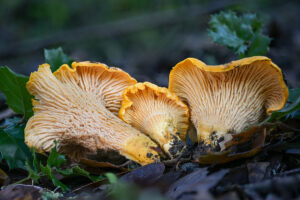It’s worth braving the chill of a rainy-season walk at Point Reyes National Seashore. Scents of spicy bay laurel, sweet-sharp conifer, and ocean brine intermingle with a fungal aroma on this windswept peninsula, home to a kaleidoscopic array of mushrooms from tiny purple parasols to stools fit for a large toad.
Increasingly these days, you’ll see scads of attractive mushrooms sporting caps in varying combinations of yellow, green, and brown. They’re Amanita phalloides—“death caps,” commonly—the source of most mushroom fatalities worldwide and the bane of unwary foragers. And they’re fruiting now.

They’re relatively recent arrivals, actually. Death caps are the first invasive ectomycorrhizal (ECM) fungus reported in North America. ECM fungi grow linked with the root tips of woody plants, allowing fungus and plant to swap nutrients. The fungi likely arrived by ship, stowing away aboard plants imported from Europe. Death caps were first spotted in 1938 on the grounds of the former Del Monte Hotel in Monterey, and now grow on the West Coast from Los Angeles to British Columbia, and east to Idaho, including deep within native forests. They emerged on the East Coast in the 1970s but, unlike their West Coast cousins, remain limited in range there.
The Bay Area’s death caps win the prize for being larger and more abundant than anywhere else, according to mycologist Benjamin Wolfe, an associate professor of biology at Tufts University. In study sites at Point Reyes National Seashore he found that death caps dominated native mushrooms by sheer mass. The mushrooms you see, of course, are just the visible sex parts of the larger fungal individual, or mycelium, living underground. “It’s difficult, especially in places like Point Reyes, to walk in the woods and see as many death caps as giant and prolific as they are and imagine that it’s not disturbing natural associations and even shifting plant communities,” says Mickey Drott, a mycologist at the U.S. Department of Agriculture’s Cereal Disease Lab in St. Paul, Minn., who studies how fungal toxins shape their evolution. “Even the mycorrhizal connections are massive,” says Debbie Viess, cofounder of the Bay Area Mycological Society. “You can see them with the naked eye!”
“It’s difficult, especially in places like Point Reyes, to walk in the woods and see as many death caps as giant and prolific as they are and imagine that it’s not disturbing natural associations and even shifting plant communities.”
Mickey Drott, U.S. Department of Agriculture mycologist
Why is the Bay Area a hotbed of death caps? First, they seem to love the mild climate. Second, they’ve gone “host jumping,” moving from the roots of imported trees such as European cork oaks to coast live oaks, which are evergreen and thus give them a year-round supply of carbon from photosynthesis. More carbon may translate to more and bigger mushrooms, which, in turn, means more spores for spreading death caps. It also means that they may be competing for underground habitat under oaks with foragers’ beloved chanterelles, Cantharellus californicus, according to Viess.

But there is a new and sexy twist to the story. Mycologist Yen-Wen (Denny) Wang, now a postdoc at Yale School of Public Health, was studying the origin of death caps at Point Reyes when he discovered mushrooms containing DNA from just one parent instead of the normal two. Then a grad student in Anne Pringle’s lab at the University of Wisconsin-Madison, Wang looked underground—and found individual mycelia that were capable of sexually reproducing either solo or with a mate. “I was pretty excited,” he recalls. To his knowledge, his observation—published recently in Nature Communications—is the first in nature of unisexual fruiting bodies among the agaricomycetes, a large group encompassing mushrooms, puffballs, and shelf fungi.
Unisexuality is a powerful reproductive strategy, if you can swing it. (It requires just one parent to produce spores.) “You only need some individuals that are capable of doing this to start establishment,” notes Wang. It’s easy to see how that may facilitate invasions. Wang suspects that investigating the invasion fronts on the West Coast may uncover more unisexual death caps.
Meanwhile, Drott’s research in collaboration with the Pringle lab adds another possibility. He and his coauthors have found that the collection of toxin genes in Californian death caps differs from those in Europe, and even varies among individual fungi. Drott hypothesizes that evolving a diverse suite of toxins may allow death caps to spread to new ecological niches—possibly by suppressing competing organisms, or by preventing various critters from noshing on the mushrooms. But both Wang and Drott emphasize that they haven’t proved these hypotheses. ”We need more data,” says Wang.

“I think it’s a really cool situation,” says ectomycorrhizal fungus expert Laura Bogar on these possible explanations for the death cap invasion. Bogar, an assistant professor of plant biology at U.C. Davis, is establishing a new lab to study mechanisms underlying plant-fungal interactions. She says that a super successful invasive species likely benefits from having such special tricks up its sleeve—and getting lucky with the environments it encounters. Indeed, she and collaborators recently published an article detailing a “fungal fight club” approach to determining the factors—fungal and environmental—that allow one ectomycorryizal fungus to outcompete others. Such studies are rare, though. Most ectomycorrhizal fungi are, so far, difficult or impossible to grow in the lab, which makes causation difficult to establish, according to Bogar.
The Pringle lab will keep working on solving this invasion mystery, aided by new genetic techniques that have transformed mycology in recent years. Meanwhile, Drott, typically a mold researcher, jokes, “Working on death caps has dramatically increased the level of interest I get at cocktail parties.”





